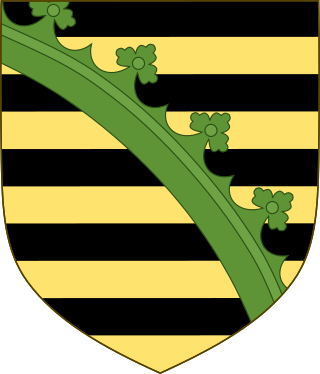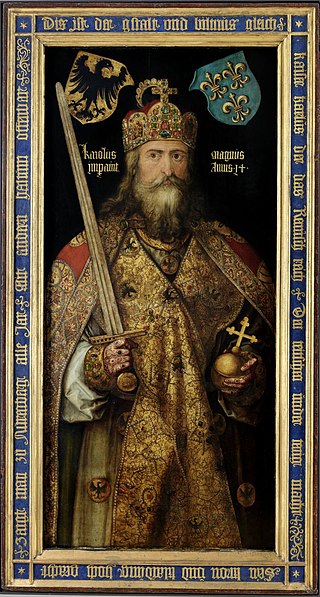This is a family tree of the monarchs of the Kingdom of Aragon .
The colors denote the monarchs from the: - House of Jiménez; - House of Barcelona; - House of Trastámara
—— The solid lines denote the legitimate descents
– – – - The dashed lines denote a marriage
· · · · The dotted lines denote the liaisons and illegitimate descents
| Sancho III the Great King of Pamplona 990–1035 r.1004–1035 | Sancha of Aibar ≈995-1070 | ||||||||||||||||||||||||||||||||||||||||||||||||||||||||||||||||||||||||||||||||||||||
| Ermesinda of Bigorre 1015–1049 | Ramiro I King of Aragon bef.1007–1063 r.1035–1063 | Agnes of Aquitaine | |||||||||||||||||||||||||||||||||||||||||||||||||||||||||||||||||||||||||||||||||||||
| Urraca | Isabella of Urgell ?-1071 | Sancho I Ramírez King of Aragon ≈1042–1094 r.1063–1094 | Ermengol III Count of Urgell 1032–1066 r.1038–1066 | Sancha of Aragón bef.1045–1097 | García Bishop of Aragon ≈1046-1086 | ||||||||||||||||||||||||||||||||||||||||||||||||||||||||||||||||||||||||||||||||||
| Bertha of Aragon ≈1075– bef.1111 | Peter I King of Aragon 1068/9–1104 r.1094–1104 | Agnes of Aquitaine 1072–1097 | Felicia of Roucy ≈1060–1123 | Alfonso VI King of León and Castile 1040–1109 r.1072–1109 | |||||||||||||||||||||||||||||||||||||||||||||||||||||||||||||||||||||||||||||||||||
| Pedro of Aragón ≈1086-1104 | Inés of Aragón ?-1103 | Ramiro II the Monk King of Aragon 1086–1157 r.1134–1157 | Agnes of Aquitaine 1105–1159 | Fernando of Aragón 1071–1094 | Alfonso I the Battler King of Aragon 1074–1134 r.1104–1134 | Urraca Queen of León and Castile 1079–1126 r.1109–1126 | |||||||||||||||||||||||||||||||||||||||||||||||||||||||||||||||||||||||||||||||||
| Ramon Berenguer IV Ct. of Barcelona 1113–1162 r.1131–1162 | Petronilla Queen of Aragon 1136-1173 r.1137–1164 | Alfonso VII the Emperor King of Castile 1105-1157 r.1127–1157 | |||||||||||||||||||||||||||||||||||||||||||||||||||||||||||||||||||||||||||||||||||||
| Pedro of Aragón 1152-bef.1158 | Ramon Berenguer III Ct. of Provence ≈1158–1181 r.1173–1181 | Dulce of Barcelona 1160–1198 | Sancho I King of Portugal 1154–1212 r.1185–1212 | Sancho Ct. of Provence 1161–1223 r.1181–1185 | Alfonso II the Chaste King of Aragon 1157–1196 r.1164–1196 | Sancha of Castile 1154/5–1208 | Sancho III King of Castile ≈1134–1158 r.1157–1158 | ||||||||||||||||||||||||||||||||||||||||||||||||||||||||||||||||||||||||||||||||
| Raymond VI Ct. of Toulouse 1156–1222 r.1194–1222 | Leonor of Aragón 1182–1226 | Sancha of Aragón 1186–1241 | Dulce of Aragon 1192–? | Béla III King of Hungary 1148–1196 r.1172–1196 | Alfonso II Ct. of Provence 1174–1209 | Garsenda of Forcalquier ≈1180–1242 | Fernando of Aragon 1190–1249 | Alfonso VIII the Noble King of Castile 1155-1214 r.1158–1214 | |||||||||||||||||||||||||||||||||||||||||||||||||||||||||||||||||||||||||||||||
| Raymond VII Ct. of Toulouse 1197–1249 r.1222–1249 | Frederick II Holy Roman Emp. 1194–1250 r.1220–1250 | Constance of Aragon 1179–1222 | Emeric King of Hungary 1174–1204 r.1196–1204 | Andrew II King of Hungary 1177–1235 r.1205–1235 | Maria of Montpellier 1182–1213 | Peter II the Catholic King of Aragon 1178–1213 r.1196–1213 | Ramon Berenguer ?-1190s | Berengaria of Castile 1179–1246 | |||||||||||||||||||||||||||||||||||||||||||||||||||||||||||||||||||||||||||||||
| Violant of Hungary 1215–1251 | James I the Conqueror King of Aragon 1208-1276 r.1213–1276 | Teresa Gil de Vidaure ?-1285 | Eleanor of Castile 1200–1244 | ||||||||||||||||||||||||||||||||||||||||||||||||||||||||||||||||||||||||||||||||||||
| Ferdinand of Aragon 1245–1250 | Sancha of Aragon 1246–bef.1275 | Maria of Aragon 1248–1267 | Sancho Archb. of Toledo 1250–1279 | James Lord of Xèrica ≈1255–1285 | Peter Lord of Ayerbe 1259–1318 | Constance of Béarn ?-1310 | Alfonso of Aragon 1229–1260 | Ferdinand III King of Castile 1201–1252 r.1217–1252 | |||||||||||||||||||||||||||||||||||||||||||||||||||||||||||||||||||||||||||||||
| Philip III King of France 1245–1285 r.1270–1285 | Isabella of Aragon 1248–1271 | Charles II King of Naples 1254–1309 r.1285–1309 | Esclaramunda of Foix 1255–1315 | James II King of Majorca 1243-1311 r.1276–1286 /1295-1311 | Peter III the Great King of Aragon 1239-1285 r.1276–1285 | Constance of Sicily 1249–1302 | Constance of Aragon 1239–1269 | Manuel of Castile 1234–1283 | Violant of Aragon 1236–1301 | Alfonso X the Wise King of Castile 1221-1284 r.1252–1284 | |||||||||||||||||||||||||||||||||||||||||||||||||||||||||||||||||||||||||||||
| Denis King of Portugal 1261–1325 r.1279–1325 | Isabel of Aragon 1271–1336 | Eleanor of Anjou 1289–1341 | Frederick III King of Sicily 1272-1337 r.1296–1337 | Robert King of Naples 1277–1343 r.1309–1343 | Violante of Aragon 1273–1302 | Alfonso III the Liberal King of Aragon 1265-1291 r.1285–1291 | Pedro of Aragón 1275–1296 | Guillerma II of Montcada | Sancho IV King of Castile 1258-1295 r.1284–1295 | ||||||||||||||||||||||||||||||||||||||||||||||||||||||||||||||||||||||||||||||
| Philip I Prince of Taranto 1278–1332 | Afonso IV King of Portugal 1291–1357 r.1325–1357 | Blanche of Anjou 1280–1310 | Marie of Lusignan 1273–1319 | James II the Just King of Aragon 1267–1327 r.1291–1327 | Elisenda of Montcada 1292–1364 | Isabella of Castile 1283–1328 | |||||||||||||||||||||||||||||||||||||||||||||||||||||||||||||||||||||||||||||||||
| Blanca of Tarento 1309?-1338? | Ramon Berenguer Ct. of Ampurias ≈1308–1366 | María Álvarez of Jérica 1310–1364 | John Patriarch of Alexandria 1304–1334 r.1327–1334 | Blanche Prioress of Sixena 1307–1348 | Isabella of Aragon 1305–1330 | Frederick III the Fair King of Germany 1289–1330 r.1314–1330 | Maria of Aragon Lady of Cameros 1299–1347 | Peter of Castile Lord of Cameros 1290–1319 | Ferdinand IV King of Castile 1285–1312 r.1295–1312 | ||||||||||||||||||||||||||||||||||||||||||||||||||||||||||||||||||||||||||||||
| Philip Despot of Romania ?-1331 | Violante 1310–1353 | Lope de Luna Lord of Segorbe ?-1360 | Juan Manuel Prince of Villena 1282–1348 | Constance 1300–1327 | James of Aragon 1296–1334 | Eleanor of Castile 1307–1359 | Alfonso IV the Kind King of Aragon 1299-1336 r.1327–1336 | Teresa d'Entença 1300–1327 | Peter Ct. of Ribagorza 1305–1381 r.1322–1381 | Joan of Foix | |||||||||||||||||||||||||||||||||||||||||||||||||||||||||||||||||||||||||||||
| Peter I King of Portugal 1320–1367 r.1357–1367 | Fernando Marquis of Tortosa 1329–1363 | John of Aragon 1331–1358 | Isabel Núñez de Lara | James III King of Majorca ≈1315 –1349 r.1324–1344 | Constance of Aragon 1318–1346 | James I Ct. of Urgell 1320-1347 r.1336–1347 | Cecilia I of Urgel ?-1384 | Philip III King of Navarre 1306-1343 r.1328–1343 | Joan II Queen of Navarre 1312–1349 r.1328–1349 | Alfonso XI King of Castile 1311–1350 r.1312–1350 | |||||||||||||||||||||||||||||||||||||||||||||||||||||||||||||||||||||||||||||
| Maria Marchioness of Tortosa 1342–after1363 | Eleanor of Portugal 1328–1348 | Sibila of Fortia ?-1406 | Peter IV el Cerimonióso King of Aragon 1319-1387 r.1336–1387 | Eleanor of Sicily 1325–1375 | Maria of Navarre 1329–1347 | Charles II the Bad King of Navarre 1332–1387 r.1349–1387 | Henry II King of Castile 1334–1379 r.1366–1379 | ||||||||||||||||||||||||||||||||||||||||||||||||||||||||||||||||||||||||||||||||
| Alfonso 1376–1377 | Peter 1379 | Isabella of Aragon 1376–1424 | James II Count of Urgell 1380–1433 r.1408–1413 | Frederick III the Simple King of Sicily 1341–1377 r.1355–1377 | Constance of Aragon 1343–1363 | Joanna of Aragon 1344–1385 | John I Count of Ampurias 1338–1398 | ||||||||||||||||||||||||||||||||||||||||||||||||||||||||||||||||||||||||||||||||
| Maria de Luna 1358–1406 | Martin the Elder King of Aragon 1356–1410 r.1396–1410 | Margaret of Prades 1388/95–1429 | Martha of Armagnac 1347–1378 | John I the Hunter King of Aragon 1350–1396 r.1387–1396 | Violant of Bar 1365–1431 | Eleanor of Aragon 1358–1382 | John I King of Castile 1358–1390 r.1379–1390 | Charles III the Noble King of Navarre 1361–1425 r.1387–1425 | Eleanor of Castile aft.1363–1416 | ||||||||||||||||||||||||||||||||||||||||||||||||||||||||||||||||||||||||||||||
| John 1380–? | James 1378–? | Matthew Count of Foix 1363–1398 | Joanna of Aragon 1375–1407 | Yolande of Aragon ≈1380 –1442 | Louis II King of Naples 1389–1399 | James 1382–1388 | |||||||||||||||||||||||||||||||||||||||||||||||||||||||||||||||||||||||||||||||||
| John I King of Portugal 1358–1433 r.1385–1433 | Margaret 1384/88-? | Martin I King of Sicily 1390–1409 r.1356–1409 | Catherine of Lancaster 1373–1418 | Henry III King of Castile 1379–1406 r.1390–1406 | Ferdinand I King of Aragon 1380-1416 r.1412–1416 | Eleanor of Alburquerque 1374–1435 | |||||||||||||||||||||||||||||||||||||||||||||||||||||||||||||||||||||||||||||||||
| Edward King of Portugal 1391–1438 r.1433–1438 | Eleanor of Aragon 1402–1445 | Maria of Aragon 1396–1445 | John II King of Castile 1405–1454 r.1406–1454 | Isabella of Portugal 1428–1496 | Maria of Castile 1401–1458 | Alfonso V King of Aragon 1396–1458 r.1416–1458 | Catherine of Castile 1403–1439 | Henry Duke of Villena 1400–1445 | |||||||||||||||||||||||||||||||||||||||||||||||||||||||||||||||||||||||||||||||
| Joan of Portugal 1439–1475 | Henry IV the Impotent King of Castile 1425–1474 r.1454–1474 | Blanche II Queen of Navarre 1424–1464 r.1461–1464 de jure | Juana Enríquez of Córdoba 1425–1468 | John II the Great King of Aragon 1398–1479 r.1458–1479 | Blanche I Queen of Navarre 1387–1441 r.1425–1441 | Peter Count of Alburquerque 1405–1438 | |||||||||||||||||||||||||||||||||||||||||||||||||||||||||||||||||||||||||||||||||
| Afonso V King of Portugal 1432–1481 r.1438–1481 | Joanna la Beltraneja 1462–1530 | Isabella I the Catholic Queen of Castile 1451-1504 r.1474–1504 | Ferdinand II the Catholic King of Aragon 1452-1516 r.1479–1516 | Joanna of Aragon 1454–1517 | Ferdinand I Ferrante King of Naples 1423–1494 r.1458–1494 | Agnes of Cleves 1422–1448 | Charles (IV) King of Navarre 1421–1461 r.1441–1461 de jure | Eleanor Queen of Navarre 1426–1479 r.1479 | Gaston IV Count of Foix 1422–1472 r.1436–1472 | ||||||||||||||||||||||||||||||||||||||||||||||||||||||||||||||||||||||||||||||
| Family tree of Spanish monarchs also Kings of Aragon | |||||||||||||||||||||||||||||||||||||||||||||||||||||||||||||||||||||||||||||||||||||||





